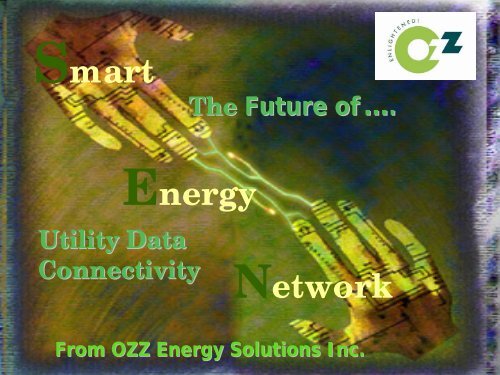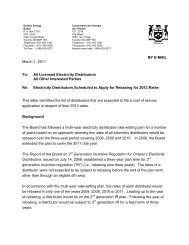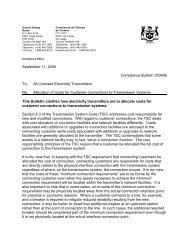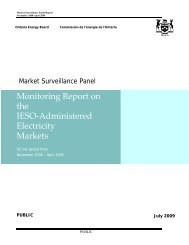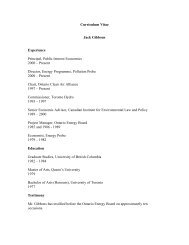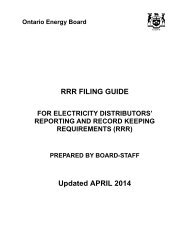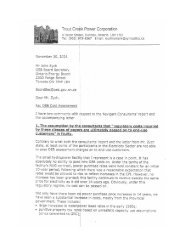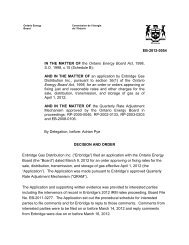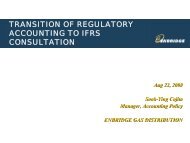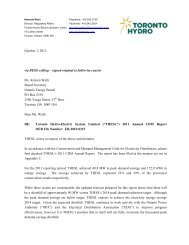OZZ corporation - Ontario Energy Board
OZZ corporation - Ontario Energy Board
OZZ corporation - Ontario Energy Board
Create successful ePaper yourself
Turn your PDF publications into a flip-book with our unique Google optimized e-Paper software.
Smart<br />
Utility Data<br />
Smart <strong>Energy</strong> Network<br />
<strong>Energy</strong><br />
Connectivity<br />
The Future of ….<br />
Alliance presentation from<br />
Motorola, <strong>OZZ</strong> & NERTEC<br />
For Union Gas<br />
July 12, 2004<br />
Network<br />
From <strong>OZZ</strong> <strong>Energy</strong> Solutions Inc.
<strong>OZZ</strong> Corporation<br />
<strong>Ontario</strong> <strong>Energy</strong> <strong>Board</strong><br />
Smart Meter<br />
Implementation<br />
Initiative<br />
September 17, 2004
Open System Platform<br />
Open Infrastructure Standards<br />
– ANSI meter communications<br />
– IEEE communications<br />
– Internet – e.g. W3C<br />
– Data Exchange – e.g. SQL, EDI<br />
– Application – e.g. Java<br />
Shared Use Networks<br />
– Published protocols<br />
– Multi-source of connectivity<br />
– Multiple application uses<br />
Information Exchange
SMI Proposition<br />
Smart Metering<br />
Infrastructure is Not<br />
Meter Reading<br />
– Smart Point-of-Service<br />
Device<br />
Cost and Quality<br />
– Integral Part of the<br />
Distribution Grid<br />
– Opportunity to serve the<br />
consumer
Smart <strong>Energy</strong> Value<br />
<strong>Ontario</strong> – Responsive Distribution Infrastructure:<br />
SmartGrid<br />
Infrastructure<br />
SmartGrid<br />
Solutions<br />
Integrated networks<br />
using intelligent device<br />
automation<br />
Integrated demand<br />
response, efficiency &<br />
reliability<br />
Unified Infrastructure<br />
SmartMeters<br />
SmartControls<br />
–SmartPipes<br />
–SmartWires<br />
–SmartAssets<br />
Smart Solutions<br />
Customer participation<br />
Peak response<br />
Reliability response
Alliance Difference<br />
1. ECONOMIC FLEXIBILITY<br />
Shared Infrastructure<br />
– Mobile asset utilization<br />
– Fixed data applications<br />
– Mobile voice & data applications<br />
Scalable Solutions<br />
– High priority first<br />
– Layer additional projects<br />
– Expandable to mass market<br />
– Multi-utility participation<br />
Economic Development<br />
– Canadian labor base<br />
– Canadian technology<br />
– <strong>Ontario</strong> industry growth<br />
Solutions<br />
Systems<br />
Smart<br />
<strong>Energy</strong><br />
Network<br />
Nets<br />
Devices<br />
Services<br />
Smart <strong>Energy</strong> Network<br />
2. RISK MITIGATION<br />
Smart Network Solutions<br />
– Wireless<br />
For the North American grid<br />
– Wired<br />
For addressable applications<br />
Resources & Experience<br />
Utility processes & standards<br />
– Canadian smart metering expertise<br />
– Measurement Canada compliance<br />
– Communication network expertise<br />
– <strong>Energy</strong> networks issues<br />
terrestrial, frequency and through<br />
put planning<br />
– <strong>Ontario</strong>-resident resources<br />
Standards Compliance<br />
– Future ready<br />
– Supplier choice
SMI Requirements Input<br />
Solutions<br />
Systems<br />
Smart<br />
<strong>Energy</strong><br />
Network<br />
Nets<br />
Devices<br />
Services<br />
Smart <strong>Energy</strong> Network
General Considerations<br />
Market<br />
– Regulatory minimum that support flexible and dynamic price signals<br />
Operational<br />
– Utility and consumer features that ensure ease of operation and use<br />
Future<br />
– Flexibility features that allow for sustainable growth and avoidance of stranded<br />
assets<br />
Performance<br />
– Data quality and reliability, access-to-information<br />
Standards and Compliance<br />
– Maximization of Open Standards (ANSI, IEEE, etc.)<br />
– Hurdles to ensure participation<br />
Quality of Service<br />
– Outage frequency and response<br />
Cost
Smart Meter Infrastructure<br />
BASIC SMI PRINCIPALS:<br />
The market requirements for SMI, should anticipate an evolving<br />
market and the integrated communications relationship with energy<br />
consumer.<br />
Under SMI the meter should become a smart point-of-service<br />
device and an integral part of the real-time distribution Grid.<br />
– SMI is not AMR or Meter Reading!<br />
– In addition to measuring load , it must be price signal and demand<br />
response ready, reliability response, quality-of-service preventative<br />
maintenance tracking (e.g. momentary outages)<br />
To avoid stranded assets, SMI should be based on open systems<br />
principals using standards at every possible level, ensuring fair and<br />
equitable supplier participation both today and in the future.<br />
SMI should be economically flexible, minimizing the current cost<br />
burden of future features
SMI Requirements<br />
1. Smart <strong>Energy</strong> Devices (meters)<br />
– Interval data resident in the<br />
device<br />
Hourly for residential<br />
15 minute for commercial<br />
Bi-directional meter data support<br />
– Support variable interval periods<br />
Ability to change intervals as<br />
needed<br />
– Hourly, 15 & 5 minutes intervals<br />
– Temporary granularity to support<br />
demand response periods and<br />
responsive customer EMS tools<br />
– 2-way communications<br />
Why?<br />
– Resident device allows<br />
for data recovery in the<br />
case of communication<br />
failure<br />
– Delivery of information<br />
to non-web connected<br />
consumer devices<br />
– Support for demand<br />
response
SMI Requirement<br />
2. Smart Reporting<br />
– Daily reporting<br />
– Hourly<br />
– Peak period<br />
– Outage<br />
– Exception<br />
– On-Demand<br />
– Real-time<br />
as long as costs are considered<br />
Why?<br />
– Different applications<br />
sources require different<br />
reporting periods:<br />
Billing – monthly<br />
Customer Service – daily,<br />
on-demand<br />
– Customer service requests<br />
for call centers operations<br />
– Change of service<br />
Demand Response<br />
– May need hourly or<br />
exception reporting for<br />
verification<br />
Customer – at least daily<br />
– On-line customer<br />
information<br />
Quality of service – event<br />
– Filtered reliability<br />
information to assist<br />
service restoration,<br />
preventative maintenance<br />
Settlements – daily
SMI Requirements<br />
3. Complete Automation Prioritizing over<br />
50kW And Selective Demand<br />
Response Locations<br />
– Geographic Coverage<br />
Urban, suburban, rural, mountainous<br />
– Commodity<br />
Electric, heat, water, gas<br />
– Customer Classes<br />
Residential, schools, commercial,<br />
government<br />
– Customer Sites<br />
Indoor, secure facilities, water pressure<br />
pumps, underground, high-rise, agricultural<br />
(i.e. pumps), streetlights etc.<br />
– Variety of Meter Types and Suppliers<br />
Forms, suppliers<br />
– Consistency with processes & procedures<br />
Labour practices, installation operating<br />
procedures, IT standards, change out,<br />
maintenance, customer communications<br />
Why?<br />
– Complete automation<br />
ensure fairness,<br />
maximizes economies-ofscale<br />
– Risk mitigation<br />
– Incremental cost on 50kW<br />
priority is likely under<br />
$400 per commercial<br />
customer and can have<br />
demand response benefits<br />
2 years earlier<br />
– Need verification<br />
information to support<br />
demand response<br />
programs, rate<br />
development and program<br />
incentives
SMI Requirements<br />
4. Economic Automation<br />
Why?<br />
– Holistic costs and benefits<br />
– Capital Costs<br />
Equipment, installation,<br />
integration, customer notification<br />
Benefits derived from all<br />
participants<br />
– Operating Costs<br />
Communications, replacement<br />
– Shared Benefits<br />
Ability to deliver benefits to<br />
legacy applications, new systems<br />
and applications<br />
– Customer/Stakeholder Accessible<br />
Web access, energy display<br />
Complimentary, Compatible with<br />
Controls<br />
Verification reporting access
SMI Requirement<br />
5. Adaptable Automation – maximize <br />
infrastructure that supports<br />
demand response.<br />
– Standards Compliance<br />
Why?<br />
– Promotes broader participation<br />
– Protects against stranded<br />
assets<br />
<br />
<br />
<br />
<br />
ANSI Metering Standards<br />
Interoperable Among Operating<br />
Systems and Databases<br />
Data Exchange<br />
Web Access<br />
–<br />
–<br />
Support for unforeseeable<br />
requirements<br />
Protect against operating<br />
“bugs”<br />
– Remotely Configurable<br />
Default and dynamic configuration<br />
– Remotely Programmable<br />
New measurement requirements,<br />
reporting frequency, new network<br />
efficiency features, new programs and<br />
business practices
SMI Considerations<br />
Should the meter be a gateway?<br />
– Appliances<br />
– Load control<br />
– Internet access<br />
NOT Necessarily Required<br />
– As long as there other paths<br />
MAY BE BENEFICIAL, as long as…<br />
– It is economic, secure and equally-accessible and provides consumer<br />
benefit.<br />
– As long as it is based on standards
Summary Recommendations<br />
Adopt industry standards on open smart metering infrastructure<br />
wherever possible<br />
Advanced commercial meters with 15 minute data<br />
Smart residential meters with a full billing cycle of interval data<br />
and 2-way communications<br />
Variable reporting periods to support multiple applications and<br />
particularly demand response<br />
Complete automation prioritizing 50kW and demand response<br />
locations<br />
Maximize infrastructure that can support future needs for<br />
demand response
Back Office<br />
Integration<br />
Utility Systems<br />
• MV-90<br />
• LodeStar<br />
• Billing<br />
• EFM/SCADA<br />
• CIS<br />
• Other<br />
Secure<br />
Utility<br />
Intranet<br />
Smart Devices:<br />
Gas Meter<br />
End-To-End Solutions<br />
Data<br />
Systems<br />
SCADA/DA Server<br />
(Instrumentation & IEDs)<br />
Electric Meter<br />
Water Meter<br />
Gateway<br />
DR Control<br />
Network Connectivity<br />
1. Private Wireless<br />
2. Public Wireless<br />
3. Public Telephone<br />
4. Wireless/Wireless<br />
5. Telephone/Wireless<br />
Private<br />
•DataTAC<br />
•iDEN<br />
Selective<br />
•PSTN •Paging<br />
Multi-utility<br />
Telephone<br />
Demand<br />
Response<br />
Public<br />
•iDEN<br />
•CDMA<br />
•GSM<br />
Smart Meter<br />
Commercial Smart Metering<br />
ANSI Meters Gas Meters &<br />
Instruments<br />
Rural Wireless<br />
Network<br />
Multi-utility Wireless<br />
Network<br />
Urban/Suburban
The Challenge<br />
Unify Diversity<br />
1. Deliver Affordable and Reliable Solutions:<br />
– Multi-Utility Requirements<br />
Electric, Gas & Water<br />
– Multiple Network Technology<br />
Selective Networks – Telephone, Public Wireless<br />
Shared Networks – Wireless WAN/LAN<br />
– New Applications<br />
Commercial Smart Metering<br />
Demand Response<br />
Residential Smart Metering<br />
– Diverse Utility Legacy Systems<br />
2. Deliver Implementable Programs
Meter<br />
Data<br />
Systems<br />
Networks<br />
Meter<br />
AMR<br />
Devices<br />
SMART ENERGY NETWORK<br />
Application<br />
Programs
Back Office<br />
Integration<br />
Commercial System Architecture<br />
Secure<br />
Utility<br />
Intranet<br />
Communication<br />
& Data Servers<br />
Network Communication<br />
Public & Private<br />
Networks<br />
• DataTAC, iDEN<br />
•CDMA/1XRTT<br />
•GSM/GPRS<br />
•Mobitex<br />
•POTS<br />
TeleReader<br />
Solutions<br />
Electric & Gas Metering<br />
ANSI Standard Meters Under Glass<br />
CellReader<br />
ANSI &Non-ANSI C&I Meters<br />
CellGateway<br />
RS232/485<br />
Gas Meters with Pulse Output<br />
NC_L801<br />
Pulse<br />
Gas Instrumentation<br />
CellGateway<br />
RS-232/485
Smart <strong>Energy</strong> Applications<br />
STEP ONE: Targeted Programs<br />
Commercial Smart Metering (CSM)<br />
Residential Demand Response (RDR)<br />
STEP TWO: Broad Scale Implementations<br />
Residential Smart Metering (RSM)<br />
STEP THREE: Shared, Incremental Programs<br />
Share Utility Projects<br />
Other Fixed Applications<br />
Other Mobile Applications


